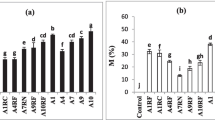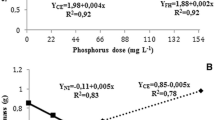Abstract
The interaction between native and introduced fungi and their effect on plant growth and mineral uptake were studied. The host plants wereLygeum spartum andAnthyllis cytisoides, the introduced fungus wasGlomus fasciculatum. The four soils used were selected from disturbed and contaminated by mining activities areas. Inoculated and uninoculated plants were grown in the unsterilized and sterilized soils (with and withouth native microflora, respectively). Plants inoculated withG. fasciculatum were higher and had higher tissue P concentration than uninoculated plants, especially inA. cytisoides. However, this inoculation was not effective in unsterilized substrates, suggesting a competition between introduced and native fungi. Concentration of mineral elements other than P varied depending on the host plant and soil. Decrease in Fe, Cu, Mn, Zn and Pb was observed in mycorrhizalA. cytiosides plants and a slight increase in Zn concentration was noted in mycorrhizalL. spartum plants. The study showed that the type of soil and their populations of native endophytes have a considerable effect on plant response to mycorrhizal symbiosis, especially in disturbed soils.
Similar content being viewed by others
References
Allen, E.B., Allen, M.F.: Carbon source of VA mycorrhizal fungi associated withChenopodiaceae from semiarid shrub-steppe.—Ecology71: 2019–2021, 1990.
Dehn, B., Schüepp, H.: Influence of VA mycorrhizae on the uptake and distribution of heavy metals in plants.—Agr. Ecosyst. Environ.29: 79–83, 1989.
Díaz, G., Honrubia, M.: Infectivity of mine soils from South-East Spain.—Agr. Ecosyst. Environm.29: 85–90, 1990.
Díaz, G., Honrubia, M.: Infectivity of mine soils from South-East Spain. II. Mycorrhizal population levels in spoilt sites.—Mycorrhiza4: 85–88, 1993a.
Díaz, G., Honrubia, M.: [Growth responses ofLygeum spartum L. to inoculation with mycorrhizal fungi and P fertilization.]—Cryptog. Mycol.14: 117–125, 1993b. [In Spanish.]
Díaz, G., Honrubia, M.: A mycorrhizal survey of plants from mine wastes from South-East of Spain. —Arid. Soil Res. Rehabilit.8: 59–68, 1994.
Díaz, G., Roldán, A., Albaladejo, J.: [Soil type as affected colonization patterns and efficiency on mycorrhizal symbiosis of sixGlomus species.]—Cryptog. Mycol.13: 47–56, 1992. [In Spanish.]
Fernández, J.A., Niell, F.X., Lucena, J.: A rapid and sensitive automated determination of phosphate in natural waters.—Limnol. Oceanogr.30: 227–230, 1985.
Gemma, J.N., Koske, R.E.: Mycorrhizae in recent volcanic substrates in Hawai.—Amer. J. Bot.77: 1193–1200, 1990.
Gianinazzi, S.: Vesicular-arbuscular (endo-) mycorrhizas: celular, biochemical and genetic aspects.— Agr. Ecosyst. Environ.35: 105–119, 1991.
Gianinazzi, S., Trouvelot, A., Gianinazzi-Pearson, V.: Conceptual approaches for the rational use of VA endomycorrhizae in agriculture: possibilities and limitations.—Agr. Ecosyst. Environ.29: 153–161, 1989.
Giovannetti, M., Mosse, B.: An evaluation of techniques for measuring vesicular-arbuscular mycorrhizal infection in roots.—New Phytol.84: 489–499, 1980.
Hayman, D.S.: The physiology of vesicular-arbuscular endomycorrhizal symbiosis.—Can. J. Bot.61: 944–963, 1983.
Heggo, A., Angle, J.S., Chaney, R.L.: Effects of vesicular-arbuscular mycorrhizal fungi on heavy metal uptake by soybeans.—Soil Biol. Biochem.22: 865–869, 1990.
Hetrick, B.A.D., Wilson, G.W.T.: Supression of mycorrhizal fungus spore germination in non-sterile soil: relationship to mycorrhizal growth response in big bluestem.—Mycologia81: 382–390, 1989.
Hetrick, B.A.D., Wilson, G.W.T.: Effects of mycorrhizal fungus species and metalaxyl application on microbial suppression of mycorrhizal symbiosis.—Mycologia83: 97–102, 1991.
Hetrick, B.A.D., Kitt, D.G., Wilson, G.T.: The influence of phosphorus fertilization, drought, fungal species and soil microorganisms on mycorrhizal growth response in tallgrass prairie plants.—Can. J. Bot.64: 1199–1203, 1986.
Hetrick, B.A.D., Kitt, D.G., Wilson, G.T.: Mycorrhizal dependence and growth habit of warm-season and cool-season tallgrass prairie plants.—Can. J. Bot.66: 1376–1380, 1988a.
Hetrick, B.A.D., Wilson, G.T., Kitt, D.G., Schwab, A.P.: Effects of soil microorganisms on mycorrhizal contribution to growth of big bluestem grass in non-sterile soil.—Soil Biol. Biochem.20: 501–507, 1988b.
Hetrick, B.A.D., Wilson, G.T., Todd, T.C.: Differential responses of C3 and C4 grasses to mycorrhizal symbiosis, phosphorus fertilization, and soil microorganisms.—Can. J. Bot.68: 461–467, 1990.
Kitt, D.G., Hetrick, B.A.D., Wilson, G.W.T.: Sporulation of two vesicular-arbuscular mycorrhizal fungi in non-sterile soil.—Mycologia79: 896–899, 1987.
Kitt, D.G., Hetrick, B.A.D., Wilson, G.W.T.: Relationship of soil fertility to suppression of the growth response of mycorrhizal big bluestem in non-sterile soil.—New Phytol.109: 473–481, 1988.
Kothari, S.K., Marschner, H., Römheld, V.: Direct and indirect effects of VA mycorrhizal fungi and rhizosphere microorganisms on acquisition of mineral nutrients by maize (Zea mays L.) in a calcareous soil.—New Phytol.116: 637–645, 1990.
López-Sanchez, M.E., Díaz, G., Honrubia, M.: Influence of vesicular-arbuscular mycorrhizal infection and P addition on growth and P nutrition ofAnthyllis cytisoides L. andBrachypodium retusum (Pers.) Beauv.—Mycorrhiza2: 41–45, 1992.
Pacovski, R.S.: Micronutrient uptake and distribution in mycorrhizal or phosphorus-fertilized soybeans.—Plant Soil95: 379–388, 1986.
Phillips, J.M., Hayman, D.S.: Improved procedures for clearing roots and staining parasitic and vesicular-arbuscular mycorrhizal fungi for rapid assessment of infection.—Trans. brit. mycol. Soc.55: 158–161, 1970.
Plenchette, C., Furlan, V., Fortin, J.A.: Responses of endomycorrhizal plants grown in a calcined montmorillonite clay to different levels of soluble phosphorus. II. Effect on nutrient uptake.—Can. J. Bot.61: 1384–1391, 1983.
Thompson, J.P.: Soil sterilization methods to show VA-mycorrhizae aid P and Zn nutrition of wheat in vertisols.—Soil Biol. Biochem.22: 29–240, 1990.
Trappe, J.M.: Phylogenetic and ecologic aspects of mycotrophy in the angiosperms from a evolutionary stand point.—In: Safir, G.R. (ed.): Ecophysiology of VA Mycorrhizal Plants. Pp. 2–25. CRC Press, Boca Raton 1987.
Author information
Authors and Affiliations
Rights and permissions
About this article
Cite this article
Díaz, G., Honrubia, M. Effect of native and introduced arbuscular mycorrhizal fungi on growth and nutrient uptake ofLygeum spartum andAnthyllis cytisoides . Biol Plant 37, 121–129 (1995). https://doi.org/10.1007/BF02913007
Received:
Accepted:
Issue Date:
DOI: https://doi.org/10.1007/BF02913007




